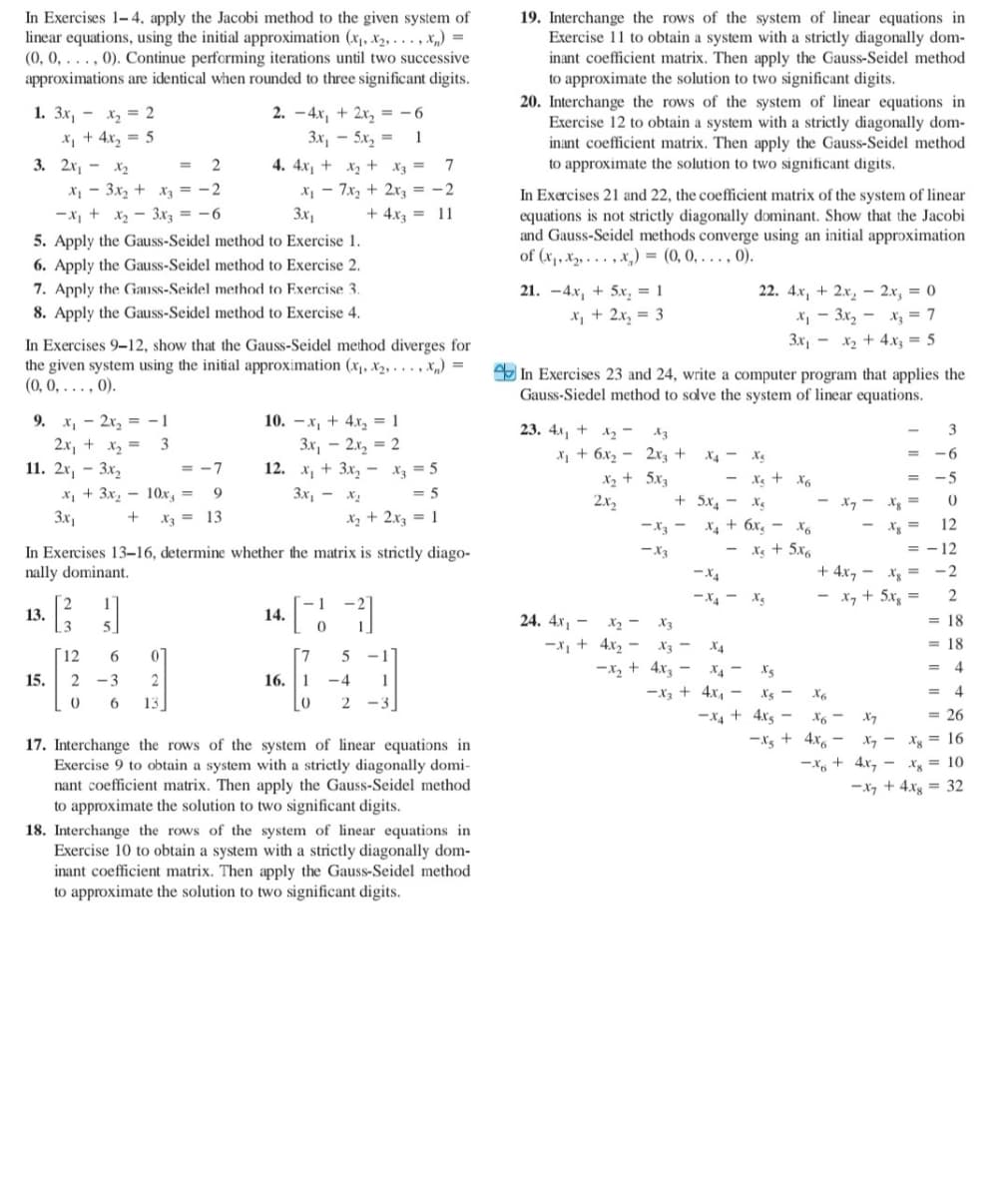17. Interchange the rows of the system of linear equations in Exercise 9 to obtain a system with a strictly diagonally domi- nant coefficient matrix. Then apply the Gauss-Seidel method to approximate the solution to two significant digits. linagr
17. Interchange the rows of the system of linear equations in Exercise 9 to obtain a system with a strictly diagonally domi- nant coefficient matrix. Then apply the Gauss-Seidel method to approximate the solution to two significant digits. linagr
Linear Algebra: A Modern Introduction
4th Edition
ISBN:9781285463247
Author:David Poole
Publisher:David Poole
Chapter2: Systems Of Linear Equations
Section2.5: Iterative Methods For Solving Linear Systems
Problem 5EQ
Related questions
Question
Please answe number 17

Transcribed Image Text:In Exercises 1- 4, apply the Jacobi method to the given system of
linear equations, using the initial approximation (x,, X2, . . . , X„) =
(0, 0, . . . , 0). Continue performing iterations until two successive
approximations are identical when rounded to three significant digits.
19. Interchange the rows of the system of linear equations in
Exercise 11 to obtain a system with a strictly diagonally dom-
inant coefficient matrix. Then apply the Gauss-Seidel method
to approximate the solution to two significant digits.
20. Interchange the rows of the system of linear equations in
Exercise 12 to obtain a system with a strictly diagonally dom-
inant coefficient matrix. Then apply the Gauss-Seidel method
to approximate the solution to two significant digits.
1. Зх, — х, 3D 2
X, + 4x, = 5
3. 2x, - x2
2. -4x, + 2x, = -6
Зх, — 5х, 3
1
4. 4x1 + x2 + X3 = 7
X1 - 3x, + xạ = -2
-x, + x2 - 3x3 = -6
X1 - 7x, + 2x3 = -2
3x1
In Exercises 21 and 22, the coefficient matrix of the system of linear
equations is not strictly diagonally dominant. Show that the Jacobi
and Gauss-Seidel methods converge using an initial approximation
of (x1, x2, . . . , x,) = (0, 0, . . . , 0).
+ 4.x3 = 11
5. Apply the Gauss-Seidel method to Exercise 1.
6. Apply the Gauss-Seidel method to Exercise 2.
7. Apply the Gauss-Seidel method to Exercise 3.
8. Apply the Gauss-Seidel method to Exercise 4.
21. -4x, + 5x, = 1
x, + 2x, = 3
22. 4x, + 2.x, - 2x, = 0
X - 3x, - x, = 7
3x, - x2 + 4.x3 = 5
In Exercises 9-12, show that the Gauss-Seidel method diverges for
the given system using the initial approximation (x1, X2, . . . , X„) =
(0, 0, ..., 0).
In Exercises 23 and 24, write a computer program that applies the
Gauss-Siedel method to solve the system of linear equations.
9. x, - 2x, = -1
2.x, + x2 =
11. 2х, - Зх,
10. — х, + 4х, 3D1
3x, – 2x, = 2
12. х, + 3х, — х, —5
23. 4x, + 12-
3
X1 + 6x2 - 2rz +
X2 + 5x3
2x2
X4 - Xg
-6
= -7
- X + x6
-5
X, + 3x, - 10x, =
3x,
9.
3x, - x2
= 5
+ 5x, - Xg
- x, - Xgs =
Xz = 13
X2 + 2x3 = 1
-X3 - X4 + 6x, - x6
- X + 5x6
- Xg =
12
= -12
In Exercises 13–16, determine whether the matrix is strictly diago-
nally dominant.
-X3
+ 4x, - Xg =
- x, + 5x =
-X4
-2
-X4 - x,
13.
14.
24. 4x, - x2 - X3
= 18
-x, + 4x2 –
X3 -
X4
= 18
12
7.
-1
-x, + 4x -
X4 -
4
15.
-3
2
16. 1
-4
1
-x3 + 4x, –
Xs -
X6
13
-3
-X4 + 4xs
X7
= 26
-Xs + 4x6
X7 - Xg = 16
-x, + 4x, - Xg = 10
17. Interchange the rows of the system of linear equations in
Exercise 9 to obtain a system with a strictly diagonally domi-
nant coefficient matrix. Then apply the Gauss-Seidel method
to approximate the solution to two significant digits.
-x7 + 4.xg = 32
18. Interchange the rows of the system of linear equations in
Exercise 10 to obtain a system with a strictly diagonally dom-
inant coefficient matrix. Then apply the Gauss-Seidel method
to approximate the solution to two significant digits.
Expert Solution
This question has been solved!
Explore an expertly crafted, step-by-step solution for a thorough understanding of key concepts.
Step by step
Solved in 3 steps with 3 images

Recommended textbooks for you

Linear Algebra: A Modern Introduction
Algebra
ISBN:
9781285463247
Author:
David Poole
Publisher:
Cengage Learning

Linear Algebra: A Modern Introduction
Algebra
ISBN:
9781285463247
Author:
David Poole
Publisher:
Cengage Learning